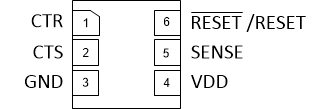JAJSIJ2C September 2020 – January 2024 TPS3899
PRODUCTION DATA
- 1
- 1 特長
- 2 アプリケーション
- 3 概要
- 4 Device Comparison
- Pin Configuration and Functions
- 5 Specifications
- 6 Detailed Description
- 7 Application and Implementation
- 8 Device and Documentation Support
- 9 Revision History
- 10Mechanical, Packaging, and Orderable Information
Pin Configuration and Functions
 Figure 5-1 DSE
Package,
Figure 5-1 DSE
Package, 6 Pin,
TPS3899 Top View
Table 5-1 Pin Functions
| PIN | I/O | DESCRIPTION | |
|---|---|---|---|
| NO. | NAME | ||
| 1 | CTR | — | Capacitor programmable reset delay: The CTR pin offers a user-adjustable delay time when returning from reset condition. Connecting this pin to a ground-referenced capacitor sets the RESET/RESET delay time to deassert. |
| 2 | CTS | — | Capacitor programmable sense delay: The CTS pin offers a user-adjustable delay time when asserting reset condition. Connecting this pin to a ground-referenced capacitor sets the RESET/RESET delay time to assert. |
| 3 | GND | — | Ground |
| 4 | VDD | I | Supply voltage pin: Good analog design practice is to place a 0.1µF ceramic capacitor close to this pin. |
| 5 | SENSE | I | This pin is
connected to the voltage that will be monitored for fixed variants or to a resistor
divider for the adjustable variant. When the voltage on the SENSE pin transistions
below the negative threshold voltage VIT-,
RESET/RESET asserts to active logic after the sense delay set
by CTS. When the voltage on the SENSE pin transistions above the positive threshold
voltage VIT- + VHYS, RESET/RESET releases
to inactive logic (deasserts) after the reset delay set by CTR. For noisy
applications, placing a 10nF to 100nF ceramic capacitor close to this pin may be needed for optimum performance. |
| 6 | RESET | O | RESET active-low output that asserts to a logic low state after CTS delay when the monitored voltage on the SENSE pin is lower than the negative threshold voltage VIT-. RESET remains logic low (asserted) until the SENSE input rises above VIT- + VHYS and the CTR reset delay expires. |
| 6 | RESET | O | RESET active-high output that asserts to a logic high state after CTS delay when the monitored voltage on the SENSE pin is lower than the negative threshold voltage VIT-. RESET remains logic high (asserted) until the SENSE input rises above VIT- + VHYS and the CTR reset delay expires. |